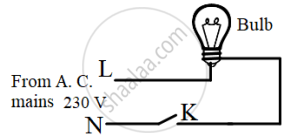Advertisements
Advertisements
Question
Which of the following is correct?
Options
Rate of change of charge is electrical power.
Rate of change of charge is current.
Rate of change of energy is current.
Rate of change of current is charge.
Solution
Rate of change of charge is current.
APPEARS IN
RELATED QUESTIONS
Explain why, tungsten is used for making the filaments of electric bulbs.
Derive the expression for the heat produced due to a current 'I' flowing for a time interval 't' through a resistor 'R' having a potential difference 'V' across its ends. With which name is this relation known?
Which metal is used to make the filament of an electric bulb?
True or False – If False give the correct answer
The fuse wire does not melts whenever there is overload in the wiring.
An electric iron consumes energy at the rate of 420 W when heating is at the maximum rate and 180 W when heating is at the minimum rate. The applied voltage is 220 V. What is the current in each case?
(a) Observe the diagram given below and state whether the bulb will glow or not when we switch on K.

(b) Is it safe to handle the bulb when the switch is OFF?
(c) Give a reason for your answer in (b).
Match the following
| 1. | Bulb | a. | Conductor |
| 2. | Electroplating | b. |
Insulator |
| 3. | Pure water | c. | Heating effect of current |
| 4. | Salt solution | d. | Chemical effect of current |
What is a trip switch?
If 220 V potential difference is applied across an electric bulb, a current of 0.45 A flows in the bulb. What must be the power of the bulb?
In which of the following applications of Iron, rusting will occur most? Support your answer with valid reason.
| A | B | C | D |
 |
 |
 |
 |
